

CURIOSITA'
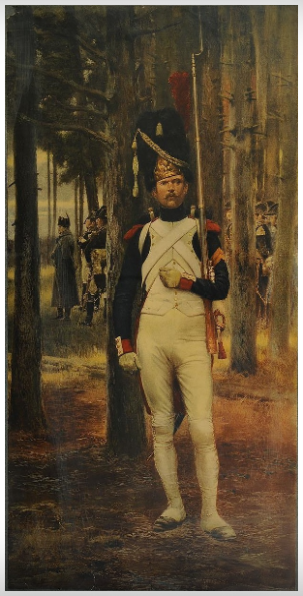
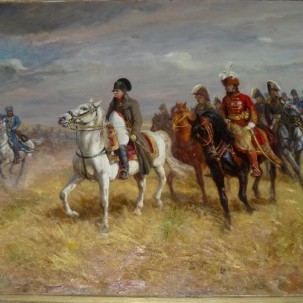
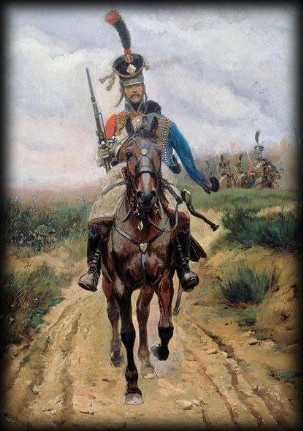
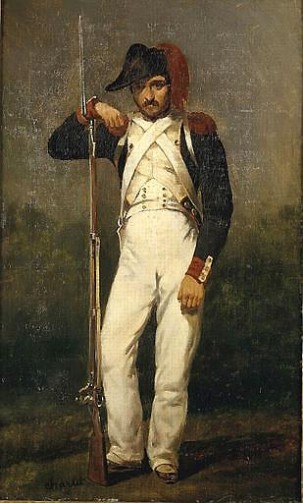
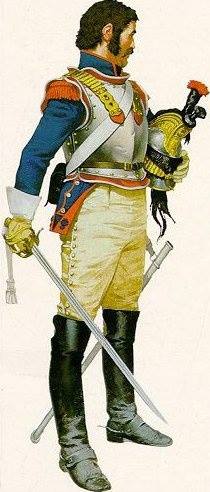
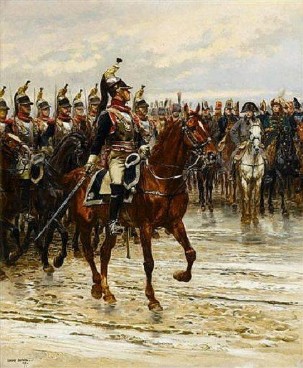
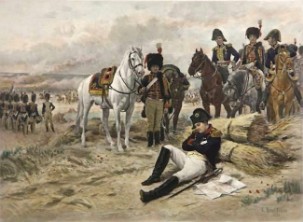
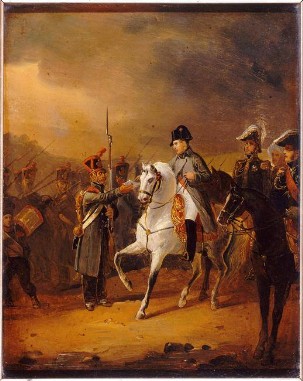
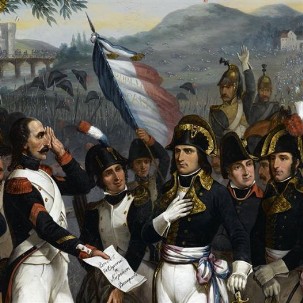
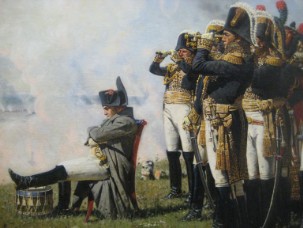
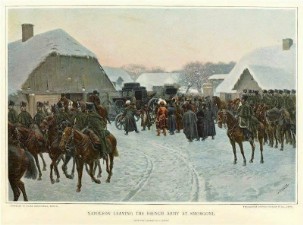
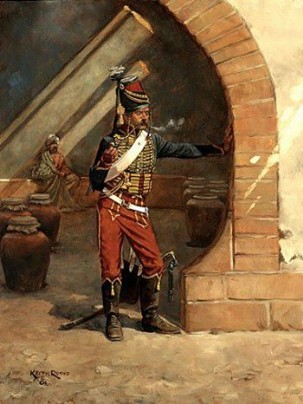
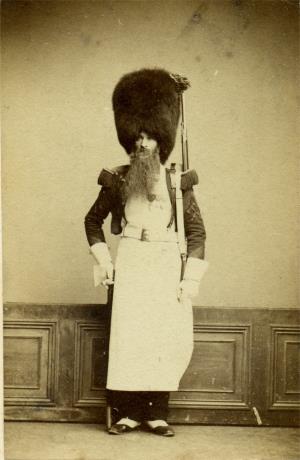
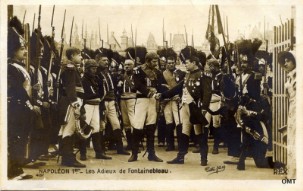
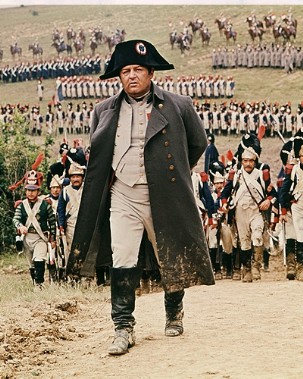
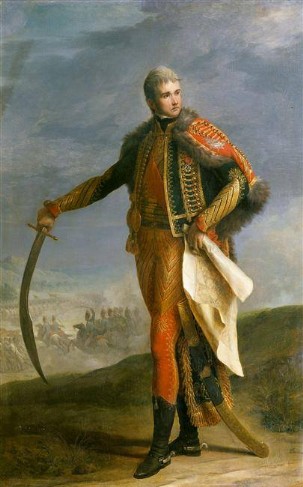
5 Maggio
In Italia il 5 maggio è tutt’ora una data celebre, ricordata grazie all’ode del Manzoni.
In Italy, the 5th of May, thanks to Manzoni’s poem is a most famous date.
40.000 Lettere
Nella sua vita, Napoleone inviò più di 40 mila lettere, per organizzare lo Stato e per dirigere le sue campagne militari. Ma solo la corrispondenza privata era scritto di suo pugno, ed era rivolta in gran parte a donne, soprattutto a Josephine e Maria Luisa, le due mogli: gli affari di cuore non potevano avere intermediari. Si tratta però del 2% di tutte le lettere censite. Le altre, quelle ufficiali, le dettava ai suoi segretari, poi venivano rilette e spesso, prima di apporre il sigillo di approvazione. Bonaparte le correggeva a mano. A meno che non si trattasse di un messaggio urgente per un ministro: in quel caso scriveva lui stesso il testo, a volte senza neppure ricopiarlo.
In his life, Napoleon sent more than 40 thousand letters, to organize the state and to direct his military campaigns. But only private correspondence was written in his own hand, and was mostly addressed to women, especially Josephine and Maria Luisa, the two wives: the affairs of the heart could not have intermediaries. However, this is 2% of all the letters surveyed. The others, the official ones, dictated them to his secretaries, then they were re-read and often, before affixing the seal of approval. Bonaparte corrected them by hand. Unless it was an urgent message for a minister: in that case he would write the text himself, sometimes without even copying it.
Altezza
Napoleone è famoso tra le altre cose per la sua altezza. Era alto 1 metro e 69 centimetri, circa 3 sopra la media dell’epoca e 3 in più rispetto all’ex presidente francese Sarkozy. Quella di Napoleone "formato mignon" sarebbe una maldicenza degli inglesi per sminuirne la fama sui campi di battaglia.
Inoltre Napoleno era attorniato da elementi della Guardia Imperiale e Granatieri la cui altezza era nettamente superiore a qualla dell'Imperatore.
Napoleon is famous among other things for his height. He was 1 meter and 69 centimeters tall, about 3 above the average of the period and 3 more than the former French president Sarkozy. That of Napoleon "size mignon" would be a slander of the English to diminish its fame on the battlefields.
Moreover Napoleno was surrounded by elements of the Imperial Guard and Grenadiers whose height was clearly higher than that of the Emperor.Aquila Napoleonica
Fuse in bronzo, le aquile presenti sulla punta degli stendardi furono distribuite al Champ-de-Mars di Parigi il 5 dicembre 1804, in una cerimonia in cui il nuovo imperatore fece prestare giuramento alla sua armata. A imitazione diretta di quelle delle antiche legioni romane, Napoleone ordinò di metterle in cima all'asta delle bandiere di ognuno dei suoi reggimenti. E non c'è da stupirsi: Bonaparte era un grandissimo fan di Giulio Cesare. Lo stimava talmente come condottiero che coniò il motto: "Cesare si nasce, non si diventa", e si paragonava spesso a lui e alle gesta dei grandi conquistatori romani per esaltare le sue imprese. Adottare i simboli della Roma Imperiale, come l'aquila di bronzo, era quindi un modo per rinverdirne i fasti. Con Napoleone, Parigi diventò "caput mundi". Come lo era stato l'Urbe.
Cast in bronze, the eagles on the tip of the banners were distributed to the Champ-de-Mars of Paris on December 5, 1804, in a ceremony in which the new emperor made his army take an oath. In direct imitation of those of the ancient Roman legions, Napoleon ordered to put them at the auction of the flags of each of his regiments. And no wonder: Bonaparte was a huge fan of Julius Caesar. He esteemed him so much as a condottiere who coined the motto: "Caesar is born, not made", and often compared himself to him and to the deeds of the great Roman conquerors to exalt his exploits. Adopting the symbols of Imperial Rome, like the bronze eagle, was therefore a way to revive its splendor. With Napoleon, Paris became "caput mundi". How the Urbe had been.
Austerlitz (notte prima della battaglia)
La notte prima della famosa battaglia (1° Dicembre 1805), Napoleone accompagnato da alcuni ufficiali, da un drappello di cacciatori a cavallo e dal suo chirurgo, eseguono l’ultima perlustrazione del campo. Tornando verso la sua tenda passa attraverso gli accampamenti dei suoi soldati che lo riconoscono e lo festeggiano calorosamente. Napoleone anche a Sant’Elena ricorderà quel momento come il più bello della sua vita.
The night before the famous battle (1 December 1805), Napoleon accompanied by some officers, a group of hunters on horseback and his surgeon, carry out the last patrol of the camp. Returning to his tent he passes through the camps of his soldiers who recognize him and celebrate him warmly. Napoleon also in Sant 'Elena will remember that moment as the most beautiful of his life.
Banca di Francia
Per controllare le finanze e regolare il credito, nel 1800 ha creato la Banca di Francia. La nostra Banca Centrale Europea ne è l’erede diretta. In 1800.
To monitor the finances and check the credit he created the Bank of France. Our Erupoean Central Bank is its direct heir.
Biografie
Sono stati scritti più di 70.000 libri su Napoleone, in diverse lingue, più di quanto siano i giorni trascorsi dalla sua morte.
There are over 70.000 books about Napoleon, in any language, an impressive number bigger than the days that passed since his death.
Bonaparte o Buonaparte?
Il padre di Napoleone si chiamava Carlo Maria Buonaparte. Cambiò il cognome in “Bonaparte” dopo la sua morte, pochi giorni prima di sposare Giuseppina e partire per la campagna d’Italia, per renderlo più adatto alla lingua francese.
Napoleon's father was named Carlo Maria Buonaparte. He changed his surname to "Bonaparte" after his death, a few days before marrying Giuseppina and leaving for the Italian campaign, to make it more suited to the French language.
Cappello bicorno
All'asta il cappello bicorno di Napoleone Bonaparte ed altri mille oggetti che fanno parte della collezione napoleonica raccolta dal Principe Luigi II. Nonostante il feltro del copricapo sia decisamente consumato e alterato per l'età, gli organizzatori sperano di recuperare dalla vendita almeno 500 mila euro (623 mila dollari). L'appuntamento per l'asta è a Fontainebleau il prossimo 15 e 16 novembre, dove oltre al celebre berretto ci saranno due lettere scritte a mano dall'imperatore, un fucile, un busto in marmo bianco, un'aquila di bronzo e la maschera mortuaria del rivoluzionario francese.
At the auction the bicorn hat by Napoleon Bonaparte and a thousand other objects that are part of the Napoleonic collection collected by Prince Louis II. Although the felt of the headgear is definitely worn and altered due to age, the organizers hope to recover at least 500 thousand euros (623 thousand dollars) from the sale. The appointment for the auction is in Fontainebleau on 15 and 16 November, where in addition to the famous cap there will be two letters handwritten by the emperor, a rifle, a bust in white marble, a bronze eagle and the mask mortuary of the French revolutionary.
Caricature
Numerosi politici, in diverse parti del mondo, hanno avuto delle caricature ispirate a Napoleone.
Many politicians, all over the world, at the some point had a comic caricature inspired by Napoleon.
Churchill
Sir Winston Churchill, un grande ammiratore di Napoleone, ha voluto scrivere una biografia documentandosi a fondo.
Sir Winston Churchill, a great admirer of Napoleon, took on the task of writing a biography about him and gathered a lot of material.
Cibo in scatola
Pochi forse sanno che è stato il grande Napoleone Bonaparte a favorire l’invenzione del cibo in scatola, nel mese di giugno del 1810, tramite un concorso da lui indetto per creare un sistema adatto a conservare i cibi da portare nelle campagne militari. A vincerlo fu il cuoco Nicholas Appert il quale, pur non conoscendo nulla di microbiologia (scienza che oltretutto a quel tempo non esisteva), sigilla il cibo in una scatoletta dopo averlo riscaldato a temperatura elevata e avere eliminato l’aria. Sarà Osterhoudt nel 1866 a brevettare la scatoletta con la chiave per aprire comodamente la confezione.
Few perhaps know that it was the great Napoleon Bonaparte who favored the invention of canned food, in the month of June 1810, through a competition he announced to create a system suitable for preserving food to be carried in military campaigns. The winner was the cook Nicholas Appert who, although he knew nothing about microbiology (a science that at that time did not exist), sealed the food in a small box after heating it to high temperature and eliminating the air. Osterhoudt in 1866 will patent the box with the key to conveniently open the package.
Cina
La prima biografia di Napoleone fu pubblicata in Cina nel 1828.
Napoleon’s first biography was written in China in 1828.
Citazioni
Le citazioni di Napoleone sono presenti ovunque nella letteratura mondiale.
Napoleon’s quotes can be found anywhere in world literature.
Codice Civile
Ci si sposa, si divorzia, si acquista una casa o si diventa cittadino italiano grazie al Codice Civile. Fu Napoleone a crearlo nel 1804. Questa notevole opera legislativa è ben presente nella nostra vita da più di duecento anni. Il Codice andò a toccare anche le regole per la successione imponendo che una parte delle eredità dovesse essere divisa in modo uguale tra i discendenti. Napoleone però volle che nel Codice la donna risultasse totalmente sottomessa all’uomo al quale doveva assoluta obbedienza: non poteva ad esempio sottoscrivere un contratto o avviare un’azione autonomamente. Le controversie tra coniugi potevano tuttavia essere risolte col divorzio (al quale non si fece gran ricorso, almeno in Italia), purché chiesto consensualmente.
We get married, get divorced, buy a house or become an Italian citizen thanks to the Civil Code. It was Napoleon who created it in 1804. This remarkable piece of legislation has been present in our lives for more than two hundred years. The Code also touched on the rules for succession, requiring that a part of the inheritance should be divided equally among the descendants. Napoleon, however, wanted the woman to be totally submissive to the man in the Code, to whom he owed absolute obedience: for example, he could not sign a contract or initiate an autonomous action. However, disputes between spouses could be resolved by divorce (which was not widely used, at least in Italy), as long as they were requested by mutual consent.
Consiglio di Stato
Sebbene Napoleone voglia una Stato forte, non vuole però uno Stato arbitrario. Ogni cittadino deve essere in grado di difendersi contro di esso. Viene creato il Consiglio di Stato, giudice dello Stato, ma anche redattore di leggi.
Although Napoleon wants a strong State, however, he doesn’t want arbitrary state. All citizens must able to defend themselves against it. The Council of State it thus established, it’s the State court, but it is also a Law editor.
Divisa della battaglia
La sera prima della battaglia gli ufficiali indossano delle uniformi bellissime, con le piume, ogni tanto un mantello si apre e si vedono tutte queste decorazioni e questi alamari, questo luccichio d’oro … sono ufficiali che si preparano per la battaglia e non avranno tempo il giorno dopo per cercare l’uniforme buona, l’hanno già indossata. Per la battaglia ci si veste bene perché i soldati hanno bisogno di riconoscere gli ufficiali, e il loro prestigio è anche legato a come sono vestiti.
The evening before the battle the officers wear beautiful uniforms, with feathers, every so often a cloak opens and you see all these decorations and these frogs, this golden shimmer ... they are officers who are preparing for battle and will have no time the next day to look for the good uniform, they have already worn it. For the battle you dress well because the soldiers need to recognize the officers, and their prestige is also related to how they are dressed.
Euro
Per facilitare gli scambi economici, nel 1802 istituì il franco germinale e in seguito lo impose in Europa. È l’antenato dell’Euro. In 1802.
To facilitate economic exchanges, he established the franc germinal and later he imposed it in Europe. It is the ancestor of the Euro currency.
Faraone Europeo
Napoleone Bonaparte è seppellito alla base della cupola degli Invalidi sotto un pavimento di porfido rosso proveniente dalla Russia su cui campeggiano ben sette sarcofagi di diversi materiali, né più né meno come un faraone dell'Occidente.
Napoleon Bonaparte is buried at the base of the dome of the Invalids under a red porphyry floor from Russia on which seven sarcophagi of different materials stand out, neither more nor less like a pharaoh of the West.
FBI
Nel 1908 il nipote di Napoleone, Carlo Bonaparte, ha creato l’FBI negli Stati Uniti.
In 1908 Charles Bonaparte, Napoleon’s nephew, founded the FBI in the United States.
Gatti Neri
Temerario (e superstizioso). E non è vero che avesse la fobia dei gatti. Lo ha precisato la storica Katharine MacDonogh nel libro "Storia dei cani e gatti a corte dai tempi del rinascimento", dopo averlo letto da più parti: non esiste alcuna evidenza storica che Napoleone soffrisse di ailurofobia. Ma era superstizioso e come molti europei del tempo si teneva lontano i gatti neri.
Bold (and superstitious). And it is not true that he had the phobia of cats. This was stated by the historian Katharine MacDonogh in the book "History of court dogs and cats from the time of the Renaissance", after having read it from many sides: there is no historical evidence that Napoleon suffered from ailurophobia. But he was superstitious and like many Europeans of the time black cats were kept away.
Gesù
Su Internet, è il personaggio storico più citato dopo Gesù.
On the internet, Napoleon is the most quoted historical figure after Jesus.
Gioconda
Rubò la Gioconda? Non è neppure vero che trafugò la Gioconda di Leonardo: secondo gli storici il dipinto si trovava in Francia dal 1517, dove lo aveva portato proprio l'autore. In seguito il quadro fu acquistato molto probabilmente dal Re Francesco I: Napoleone, grande appassionato d'arte nel 1800 si limitò ad appenderlo nelle stanze della moglie Josephine e in seguito la Monna Lisa entrò a far parte della collezione permanente del Louvre (che all'epoca si chiamava Museo Napoleone). La bufala del furto napoleonico nasce forse dal fatto che i soldati napoleonici trafugarono davvero alcune opere d'arte durante la campagna d'Italia. Ma non la Gioconda.
Did he steal the Mona Lisa? Nor is it true that he stole Leonardo's Gioconda: according to historians, the painting had been in France since 1517, where the author had brought it. Later the painting was probably purchased by King Francis I: Napoleon, a great art lover in the 1800s, simply hung it in his wife Josephine's rooms and later the Mona Lisa became part of the permanent collection of the Louvre (which era called Napoleon Museum). The hoax of Napoleonic theft probably derives from the fact that the Napoleonic soldiers really stole some works of art during the Italian campaign. But not the Mona Lisa.
Guanti bianchi di Napoleone
La biblioteca ambrosiana di Milano conserva i guanti bianchi che Napoleone utilizzò durante la battaglia di Waterloo.
The Ambrosian library in Milan preserves the white gloves that Napoleon used during the battle of Waterloo.
Guardia Imperiale
Per essere ammessi nella Guardia Imperiale, l'élite dell'élite, bisogna avere almeno cinque anni di servizio, essere stato segnalato per degli atti di coraggio e una condotta impeccabile. Questi guerrieri formidabili sono fermamente attaccati al loro Imperatore.
To be admitted to the Imperial Guard, the elite of the elite, one must have at least five years of service, to have been reported for acts of courage and impeccable conduct. These formidable warriors are firmly attached to their Emperor.
Il cane di Joséphine de Beauharnais
Joséphine (1763 - 1814), prima moglie di Napoleone Bonaparte, aveva un carlino chiamato Fortuna, che veniva da lei usato per mandare a Napoleone messaggi privati. Si dice che nella prima notte di nozze Napoleone si fosse rifiutato di permettere a Fortuna di dormire nel letto con loro e Fortuna lo avesse morso. Joséphine avrebbe allora detto: "Se il carlino non dorme nel nostro letto, neanch'io!". Da allora Napoleone condivise il suo letto con Joséphine e il suo carlino.
Joséphine (1763 - 1814), Napoleon Bonaparte's first wife, had a pug called Fortuna, which she used to send private messages to Napoleon. It is said that on the first wedding night Napoleon refused to allow Fortuna to sleep in bed with them and Fortuna had bitten him. Josephine would then have said: "If the pug does not sleep in our bed, neither will I." Since then Napoleon shared his bed with Joséphine and his pug.
Incoronazione
Bonaparte fu anzitutto un grande comunicatore. E proprio pe questo pretese che la sua salita al trono imperiale, avvenuta il 2 dicembre 1804, fosse ricordata con un grande con un grande dipinto. Per realizzarlo scelse l'affermato pittore Jacques-Louis David (1748-1825), che eseguì questo disegno preparatorio, ma non vi ritrasse Maria Letizia Romolino, l'amata madre del conquistatore, e disegnò l'imperatore che si incoronava da solo, come di fatto era avvenuto nella cattedrale di Notre-Dame. Napoleone infatti chiese al Papa di incoronarlo, ma nel momento cruciale si incoronò da solo: solo Napoleone poteva incoronare Napoleone!
Quando vide la bozza del quadro, N. chiese ed ottenne due importanti correzioni. Così nell'opera definitiva sua madre è addirittura al centro del quadro, e lui è dipinto nel momento in cui incorona la moglie Josephine di Beauharnais, con un gesto che gli conferisce un'immagine meno autoritaria e più nobile. Anche in questo caso, la rappresentazione della realtà era plasmata dalla strategia politica.
Bonaparte was above all a great communicator. And precisely for this reason he claims that his ascent to the imperial throne, which took place on December 2, 1804, was remembered with a large one with a large painting. To achieve this, he chose the established painter Jacques-Louis David (1748-1825), who executed this preparatory drawing, but did not portray Maria Letizia Romolino, the beloved mother of the conqueror, and designed the emperor who crowned himself, as in fact it had happened in the cathedral of Notre-Dame. Napoleon in fact asked the Pope to crown him, but at the crucial moment he crowned himself: only Napoleon could crown Napoleon!
When he saw the draft of the painting, N. asked and obtained two important corrections. Thus in the definitive work his mother is even at the center of the picture, and he is painted at the moment when he crowns his wife Josephine of Beauharnais, with a gesture that gives him a less authoritarian and nobler image. Also in this case, the representation of reality was shaped by political strategy.
When he saw the draft of the painting, N. asked and obtained two important corrections. Thus in the definitive work his mother is even at the center of the picture, and he is painted at the moment when he crowns his wife Josephine of Beauharnais, with a gesture that gives him a less authoritarian and nobler image. Also in this case, the representation of reality was shaped by political strategy.
Inno Polacco
Il nome di Napoleone è citato nell’inno polacco.
Napoleon’s name is quoted in the Polish anthem.
Italiano
I Buonaparte vantavano nobili origini toscane, anche se si erano trasferiti in Corsica, allora genovese, già nel 1567. Lo stesso Napoleone confessò: “Io sono italiano o toscano, piuttosto che còrso”. Questa frase però non deve trarre in inganno. Raccontava di essere italiano, ma dell’Italia diceva peste e corna: come ogni politico badava al sodo, a quello che poteva tornargli utile. La familiarità linguistica (in Corsica l’italiano era lingua ufficiale) gli rendeva congeniale l’Italia e probabilmente è vero che ci metteva piede con piacere, dato che vi si era affermato come militare e politico. Ma in più occasioni Napoleone si fece scappare valutazioni non troppo positive sul carattere italico. Come quando, rivolto al viceré d’Italia, il figlioccio Eugenio Beauharnais disse: “Avete torto a pensare che gli italiani siano come fanciulli: c’è del malanimo in loro; non fategli dimenticare che io sono padrone di fare ciò che voglio, questo è necessario per tutti i popoli, ma soprattutto per gli italiani, che non obbediscono che alla voce del padrone”.
The Buonaparte family boasted noble Tuscan origins, even though they had moved to Corsica, then Genoese, already in 1567. Napoleon himself confessed: "I am Italian or Tuscan, rather than Corsican". However, this sentence should not be misleading. He told of being Italian, but in Italy he said plague and horns: like any politician he looked after the hard way, at what could be useful to him. The linguistic familiarity (in Corsica the Italian was the official language) made it congenial to Italy and probably it is true that he set foot there with pleasure, given that he had established himself as military and political. But on several occasions, Napoleon gave up not too positive evaluations on the Italic character. Like when, addressed to the viceroy of Italy, the godson Eugenio Beauharnais said: "You are wrong to think that Italians are like children: there is malice in them; do not make him forget that I am the master of doing what I want, this is necessary for all peoples, but above all for the Italians, who do not obey the voice of the master ".
Legione d'Onore
La Legione d’Onore fu istituita per premiare il merito indipendentemente dalla nascita e condizioni sociali. Da allora, la maggior parte degli ordini nel mondo si sono ispirati ad essa.
The Legion of honor was created to reward merit regardless of birth and social conditions. Since then, it was a source of inspiration to most orders worldwide.
Legislatore
Sul web circola la leggenda che in Francia ancora oggi è vietato dare a un maiale il nome Napoleone: in realtà non ne parla nessun articolo del Codice Napoleone. Che sia un'altra diceria? In realtà il più importante lascito dell’età napoleonica sono le riforme attuate fra il 1800 e il 1804, anni durante i quali fu redatto il Codice civile, detto anche Codice Napoleone, approvato il 21 marzo 1804. Durante il periodo napoleonico, il sistema amministrativo francese abbandonò il decentramento della rivoluzione e si caratterizzò per un fortissimo accentramento statale. Il Codice andò a toccare anche le regole per la successione imponendo che una parte delle eredità dovesse essere divisa in modo uguale tra i discendenti. Napoleone però volle che nel Codice la donna risultasse totalmente sottomessa all’uomo al quale doveva assoluta obbedienza: non poteva ad esempio sottoscrivere un contratto o avviare un’azione autonomamente. Le controversie tra coniugi potevano tuttavia essere risolte col divorzio (al quale non si fece gran ricorso, almeno in Italia), purché chiesto consensualmente.
On the web the legend circulates that in France it is still forbidden to give a pig the name Napoleon: in reality no article of the Napoleon Code speaks about it. What is another rumor? In reality the most important legacy of the Napoleonic age are the reforms implemented between 1800 and 1804, years during which the Civil Code, also known as the Napoleon Code, was approved and approved on 21 March 1804. During the Napoleonic period, the administrative system French abandoned the decentralization of the revolution and was characterized by a very strong state centralization. The Code also touched on the rules for succession, requiring that a part of the inheritance should be divided equally among the descendants. Napoleon, however, wanted the woman to be totally submissive to the man in the Code, to whom he owed absolute obedience: for example, he could not sign a contract or initiate an autonomous action. However, disputes between spouses could be resolved by divorce (which was not widely used, at least in Italy), as long as they were requested by mutual consent.
Letti da campo (prima della battaglia)
I soldati la notte prima della battaglia dormivano direttamente sulla nuda terra, magari sopra un po’ di paglia, se avevano la fortuna di trovarla …
The soldiers the night before the battle slept directly on the bare ground, perhaps above a little straw, if they were lucky enough to find it ...
Lezioni di inglese
Tre mesi
dopo lo sbarco sull'Isola di Sant'Elena, confinato nella residenza di Longwood
è strettamente sorvegliato, l'imperatore sconfitto non aveva più notizie
d'attualità se non dai rari giornali inglesi, in arrivo in quel luogo
inospitale con mesi di ritardo.
Decise così
di prendere lezioni dal visconte Emmanuel de Las Cases, memorialista che più
tardi diventerà famoso con le sue "Memorie di Sant'Elena".
Determinato
com'era, dopo una ventina di ripetizioni poteva già leggere da solo i giornali
inglesi. Le lezioni iniziarono il 17 gennaio 1816.
Three
months after the landing on the Island of St. Helena, confined to the residence
of Longwood, it is closely guarded, the defeated emperor no longer had news of
actuality except from the rare English newspapers, arriving in that
inhospitable place with months of delay .
He decided to take lessons from Viscount Emmanuel de Las Cases, a memorialist who later became famous with his "Memoirs of Saint Helena".
Determined as he was, after twenty repetitions he could already read the English newspapers by himself. Lessons began on 17 January 1816.
He decided to take lessons from Viscount Emmanuel de Las Cases, a memorialist who later became famous with his "Memoirs of Saint Helena".
Determined as he was, after twenty repetitions he could already read the English newspapers by himself. Lessons began on 17 January 1816.
Licei
Nel 1802 Napoleone creò i licei. Qui gli studenti seguono un programma comune per poi accedere all’Università. Chi è stato liceale deve quindi i propri anni di studi al liceo di Napoleone! Grazie a Napoleone venne sviluppata l’istruzione superiore con l’introduzione dei licei statali, scuole impegnative e riservate ai giovani di buona famiglia o di eccezionale talento. I licei napoleonici erano, come quelli di oggi, pubblici, finanziati cioè dal denaro raccolto con le tasse e con gli investimenti del governo, e i docenti erano dipendenti dello Stato. Analogamente a quanto accade ancora oggi, le scuole private venivano sottoposte a controlli e verifiche da parte di funzionari statali e nel 1806 venne introdotto il monopolio statale dell’istruzione universitaria una sorta di Ministero per la ricerca e l’università.
In 1802 Napoleon established the first lycées. Here students follow a common programme and then go to University. Therefore, those of you who were lycée students owe their years of high school studies to Napoleon! Thanks to Napoleon, higher education was developed with the introduction of state high schools, demanding schools reserved for young people of good family or exceptional talent. The Napoleonic high schools were, like those of today, public, that is financed by the money collected with taxes and government investments, and the teachers were employees of the State. Similarly to what is still happening today, private schools were subjected to checks and checks by state officials and in 1806 the state monopoly of university education was introduced, a sort of Ministry for research and university.
Luigi Mascheroni
Più che un bibliofilo, era un collezionista. Più che uno studioso specializzato, un lettore onnivoro. Più che uno scrittore, un uomo che credeva nella scrittura. Di certo la passione di Napoleone Bonaparte per la lettura e per i libri - che si manifestò prima dell'interesse per l'arte della guerra e la politica - era immensa. Fu un lettore smodato, un accumulatore seriale di volumi, un «costruttore» di biblioteche (ne fece allestire una in ognuna delle sue residenze private: nelle librerie di Compiegne, Saint-Cloud, Fontainebleau, Trianon e delle Tuileries mise insieme 60mila volumi, mentre all'Elba, pur se in esilio, ne raccolse 2.378), uno che da giovane provò a dedicarsi all'export di libri (ma cambiò idea quando la spedizione di una cassa di volumi a Basilea non andò a buon fine), fu un prolifico autore di aforismi e l'autore del primo bestseller dell'età moderna: Mémorial de Sainte-Hélène (prima edizione 1822-23), vero livre de chevet della borghesia europea per alcune generazioni...Napoleone e i libri è un bel titolo (Henry Beyle, pagg. 40, euro 20). È di Ernesto Ferrero, sabaudo, napoleonico e uomo di editoria che allo studio della vita dell'Imperatore e alla diffusione dei libri ha dedicato l'esistenza. E in effetti, ce ne sono di cose da raccontare in materia. Ad esempio? Che il generale: 1) aveva idee molto chiare in campo editoriale: sulle orme di Aldo Manuzio, pensava di pubblicare una serie di edizioni commentate degli autori classici, a cominciare da Strabone, ma poi trovò altro da fare nella vita; 2) era un amante dei libri molto ordinato ed elegante: tutti i suoi volumi erano contrassegnati da un timbro ovale con al centro l'aquila imperiale circondata dalla scritta Cabinet de l'Empereur; 3) si può considerare il fondatore della comunicazione moderna («L'opinione pubblica è tutto», diceva), tanto che trasformò il Moniteur in un foglio di regime esemplare; 4) era un lettore curioso e vario (divorava trattati di tecnica militare, memorie di grandi del passato, manuali tecnici - perché vedeva sempre nei libri prima di tutto uno strumento di lavoro - oltre che libri di filosofia e letteratura) ma anche acuto e disinteressato, tanto che Ferrero fa notare quanto fosse portato alla critica letteraria: a Sant'Elena vergò un luminoso elogio dell'Iliade, strapazzò il Voltaire drammaturgo, fu il primo a dire che la storiografia è sempre quella scritta dai vincitori; 5) soprattutto - ecco uno straordinario punto a suo favore - disprezzava i «letterati». Narcisi, incompetenti, confusi e leccazzampe (era il primo a ridere degli eccessi dei suoi agiografi): «Ah, que les gens de lettres sont bêtes!» lasciò scritto.
More than a bibliophile, he was a collector. More than a specialized scholar, an omnivorous reader. More than a writer, a man who believed in writing. Certainly Napoleon Bonaparte's passion for reading and books - which manifested itself before the interest in the art of war and politics - was immense. He was an immoderate reader, a serial accumulator of volumes, a "builder" of libraries (he had one set up in each of his private residences: in the libraries of Compiegne, Saint-Cloud, Fontainebleau, Trianon and the Tuileries he put together 60 thousand volumes, while to Elba, although in exile, he collected 2,378), one who as a young man tried to devote himself to the export of books (but he changed his mind when the shipment of a case of volumes in Basel did not go well), he was a prolific author of aphorisms and the author of the first bestseller of the modern age: Mémorial de Sainte-Hélène (first edition 1822-23), true livre de chevet of the European bourgeoisie for some generations ... Napoleon and the books is a beautiful title (Henry Beyle, pages 40, 20 euros). It is Ernesto Ferrero, a Savoyard, Napoleonic and publishing man, who dedicated his life to the study of the life of the Emperor and the spread of books. And indeed, there are things to tell about it. For example? That the general: 1) had very clear ideas in the publishing field: following in the footsteps of Aldo Manuzio, he planned to publish a series of commented editions of the classical authors, starting with Strabo, but then he found something else to do in life; 2) he was a very neat and elegant book lover: all his volumes were marked with an oval stamp with the imperial eagle surrounded by the writing Cabinet de l'Empereur; 3) one can consider the founder of modern communication ("Public opinion is everything", he said), so much so that he transformed the Moniteur into an exemplary sheet; 4) he was a curious and varied reader (he devoured treatises on military technique, memories of the great of the past, technical manuals - because he always saw books in the first place as a working tool - as well as books on philosophy and literature) but also acute and disinterested , so much so that Ferrero points out how much he was led to literary criticism: on Sant'Elena he penned a luminous eulogy of the Iliad, he beat the Voltaire dramatist, he was the first to say that historiography is always written by the winners; 5) above all - here is an extraordinary point in his favor - he despised the "literati". Daffodils, incompetent, confused and leccazzampe (he was the first to laugh at the excesses of his hagiographers): "Ah, les les gens de lettres sont bêtes!" He left written.
Mano nel Gilet
Che fosse un tic? Un segno del feroce mal di stomaco di cui soffriva? No, semplicemente un'usanza diffusa tra coloro che si prestavano a un ritratto tra il 18esimo e il 19esimo secolo.
Was it a tic? A sign of the ferocious stomachache from which he suffered? No, simply a widespread custom among those who lent themselves to portraits between the 18th and 19th centuries.
Maschera mortuaria
Le maschere mortuarie erano un antico sistema per creare il calco esatto del viso di un personaggio importante al momento della morte. Prima dell'invenzione della fotografia, si trattava di uno dei modi più efficaci per riprodurre con oggettività le fattezze di una persona: il pennello di un pittore poteva rivelarsi meno affidabile. Durante il regno napoleonico, la Francia sviluppò una forte tradizione di questi oggetti funebri. Così, quando il 5 maggio 1821 l'imperatore morì, gli venne realizzata una maschera mortuaria. A prendere l'impronta il 7 maggio fu Francis Burton, il medico della guarnigione inglese a Sant'Elena, che aveva trovato del gesso sull'isola. Burton fu assistito da Francesco Antonmarchi, anatomista, medico personale di Napoleone, e dalla moglie del maresciallo e amico Bertrand, che presero l'impronta della parte centrale del viso (occhi, naso e bocca). La maschera originale è andata sicuramente persa, ma servì per plasmare copie successive che furono realizzate a Sant'Elena e in tutta Europa. Ed era solo l'inizio. In tutto il mondo esistono moltissime riproduzioni del volto di Napoleone sul letto di morte: una delle ultime è stata ritrovata a Napoli nel 2014.
The death masks were an ancient system to create the exact cast of an important character's face at the time of death. Before the invention of photography, it was one of the most effective ways to objectively reproduce a person's features: a painter's brush could prove less reliable. During the Napoleonic reign, France developed a strong tradition of these funeral objects. Thus, when the emperor died on 5 May 1821, a death mask was created. The impression was taken on 7 May by Francis Burton, the doctor of the English garrison at Saint Helena, who had found some chalk on the island. Burton was assisted by Francesco Antonmarchi, anatomist, Napoleon's personal physician, and by the wife of Marshal and friend Bertrand, who took the imprint of the central part of the face (eyes, nose and mouth). The original mask was definitely lost, but it served to shape successive copies that were made on Sant'Elena and throughout Europe. And it was only the beginning. Worldwide there are many reproductions of Napoleon's face on his deathbed: one of the last was found in Naples in 2014.
Materasso di Napoleone
A Dego, in Valbormida, c’è il “materasso di Napoleone”, un enorme roccia su cui si dice che Napoleone abbia riposato durante la campagna del 1796.
In Dego, in Valbormida, there is the “mattress of Napoleon”, a huge rock on which Napoleoni s said to have rested during the 1796 campaign.
Mille amorosi baci
Le lettere d’amore di Napoleone a Giuseppina sono considerate fra le più belle della lingua francese.
Napoleon’s love letters to Josephine are considered the most beautiful letters in the French language.
Millefoglie
Tra i dolci più famosi in Russia c’è la Millefoglie che viene chiamata “Napoleon”.
One of the most famous Russian cakes, the mille-feuille, is called “Napoleon”.
Nabulio
Da bambino, Napoleone veniva chiamato dalla sua famiglia con il soprannome di “Nabulio”.
As a child, Napoleon was called by his family with the nickname "Nabulio".
Napoleon
Una parola per diversi significati. Un ’Napoleon’ può essere una moneta francese, un tipo di scarpone, una varietà di ciliegia o una pistola.
A word for different meanings. A 'Napoleon' can be a French coin, a type of boot, a variety of cherries or a pistol.
Parure di Josephine
La corte dell'Imperatore doveva essere sfolgorante e Josephine di Beauharnais, l'amatissima imperatrice, la più radiosa delle dame. Ecco perché Bonaparte le donava magnifici gioielli come questo, realizzato da Marie-Etienne Nitot, gioielliere ufficiale della coppia imperiale, che creò pezzi passati alla storia come simbolo del fasto e del potere napoleonico. Per esempio il corredo di gioielli per il matrimonio, o le preziose tiare che l'imperatrice, considerata la donna più elegante d'Europa, sfoggiava a corte (quando morì, nel 1814, il suo patrimonio in gioie fu stimato a più di 3 milioni di franchi del tempo). Non solo: Nitot creò anche la corona, la spada cerimoniale e i vari ornamenti di corte che Bonaparte indossò il giorno dell'incoronazione.
The emperor's court was to be blazing and Josephine of Beauharnais, the beloved empress, the most radiant of the ladies. This is why Bonaparte gave her magnificent jewels like this, made by Marie-Etienne Nitot, official jeweler of the imperial couple, who created pieces passed into history as a symbol of Napoleonic pomp and power. For example the wedding jewelry set, or the precious tiaras that the empress, considered the most elegant woman in Europe, sported at court (when she died, in 1814, her joyful fortune was estimated at more than 3 million of francs of time). Not only that, Nitot also created the crown, the ceremonial sword and various court ornaments that Bonaparte wore on the day of the coronation.
Perosa Canavese (TO)
In una chiesa a Perosa Canavese (vicino ad Ivrea, dedicata a San Rocco, riposano Louise e Jenny dei Conti de La Tour-Maubourg, nipoti del marchese e Generale Gilbert du Motier de La Fayette, il francese che servì la causa dell'indipendenza americana.
In a church in Perosa Canavese (near Ivrea, dedicated to San Rocco, rest Louise and Jenny of the Counts of La Tour-Maubourg, grandchildren of the Marquis and General Gilbert du Motier de La Fayette, the French who served the cause of American independence.
Piramide di Cheope
Nella notte tra il 12 e il 13 agosto del 1799, il generale Napoleone Bonaparte fu condotto in tutta segretezza nella Camera del Re, nel cuore della piramide di Cheope, dove un misterioso profeta dalle vesti scarlatte gli rivelò ciò che il destino gli riservava. Era quello lo scopo recondito della campagna d'Egitto: trovare la leggendaria Camera dell'Eternità, che custodisce la mappa del futuro, il significato della vita, il segreto dell'immortalità. Avvenne davvero, quel mistico incontro, o fu frutto dell'immaginazione di Napoleone? Chi era l'Uomo Rosso che dopo quella fatidica notte più volte gli comparve nei momenti cruciali della sua ascesa e della sua caduta? Davvero la spoglia cella al cuore della Grande Piramide di Giza, priva di iscrizioni geroglifiche, e contenente solo un sarcofago vuoto, era la Camera dell'Eternità? Non v'è prova che quella visita notturna sia veramente avvenuta, e l'Uomo Rosso è generalmente ritenuto un parto della fantasia di Napoleone, che ne riferì, ma confusamente, ripetute apparizioni.
In the night between 12 and 13 August 1799, General Napoleon Bonaparte was conducted in complete secrecy in the King's Chamber, in the heart of the pyramid of Cheops, where a mysterious prophet with scarlet robes revealed to him what destiny reserved for him. That was the hidden purpose of the Egyptian campaign: to find the legendary Chamber of Eternity, which holds the map of the future, the meaning of life, the secret of immortality. Did that really happen, that mystical encounter, or was it the fruit of Napoleon's imagination? Who was the Red Man who after that fateful night repeatedly appeared to him at crucial moments of his rise and fall? Was the bare cell at the heart of the Great Pyramid of Giza, devoid of hieroglyphic inscriptions, and containing only an empty sarcophagus, was the Chamber of Eternity? There is no evidence that this nocturnal visit has actually taken place, and the Red Man is generally considered to be a figment of Napoleon's imagination, which he reported, but confusedly, repeated appearances.
Pizzicotti
A quanto pare, l’imperatore aveva un’abitudine che non tutti apprezzavano. Louis Constant Wairy, il capo maggiordomo e confidente generale dell'imperatore, nelle sue memorie scrive aneddoti sulle pericolose mani di Napoleone, affermando che quando il suo padrone era di buon umore pizzicava i suoi amici più cari sulla punta delle orecchie. Era anche noto per dare pizzicotti sui nasi delle signore, sulle guance dei suoi amici fin quando non diventavano blu e sui menti dei bambini finché le madri non ne avevano abbastanza.
Apparently, the emperor had a habit that not everyone appreciated. Louis Constant Wairy, the chief butler and general confidant of the emperor, in his memoirs writes anecdotes about the dangerous hands of Napoleon, stating that when his master was in a good mood he pinched his closest friends on the tips of his ears. He was also known for pinching the noses of the ladies, on the cheeks of his friends until they turned blue and on the minds of the children until the mothers had enough.
Prefetture
Napoleone voleva uno Stato forte su tutto il territorio. I prefetti, investiti di ampi poteri di polizia, sarebbero stati i suoi delegati nelle province. Da allora, questo tipo di organizzazione è stato adottato da molti paesi.
Napoleon wanted a strong State throughout the country. The prefects, vested with broad poilce powers, were his deputies in the provinces. Since then, this kind of organizatione has been adopted by many countries.
Religione
Durante il proprio Consolato, Napoleone proclama la pace religiosa. Ora tutti possono praticare il proprio culto, sia esso cattolico, protestante o ebreo, senza essere al di sopra della legge. Il potere spirituale e quello temporale vengono separati. La maggior parte delle società democratiche sono costruite su questo modello.
During his Consulate Napoleon proclaims religious peace. Now everyone can practice their religion, whether Catholic, Protestant, or Jew, without being above the law. Spiritual and temporal powers are thus separated. Most democratic societies are built on this model.
Rievocazioni
Nel 2015, più di duecentomila persone hanno partecipato alla rievocazione della battaglia di Waterloo.
In 2015, over two hundred thousand people took part in the reenactment of the battle of Waterloo.
Rivoluzionari francesi
Molti dei rivoluzionari francesi avevano combattuto al fianco degli americani contro gli inglesi. Ricordiamo Lafayette tra i più grandi. Ma tra questi non possiamo dimenticare Berthier, giovanissimo ufficiale francese della piccola nobiltà che in seguito affiancherà Napoleone (il quale disse di lui: ho trovato un pollastro e ne ho fatto un’aquila…). Napoleone lo farà infatti Capo di Stato Maggiore.
Many of the French revolutionaries had fought alongside the Americans against the British. We remember Lafayette among the greatest. But among these we cannot forget Berthier, a very young French officer of the small nobility who later joined Napoleon (who said of him: I found a chicken and I made an eagle ...). Napoleon will do it in fact Chief of Staff.
Romanziere
Napoleone fu anche romanziere. Nel 1795 scrisse un romanzo romantico chiamato “Clisson et Eugenie” che rimase inedito fino al 1920.
Napoleon was also a novelist. In 1795 he wrote a romantic novel called "Clisson et Eugenie" which remained unpublished until 1920.
Siti internet
Esistono più di 4500 siti napoleonici nel mondo.
There are more than 4500 Napoleonic sites in the world.
Stati Uniti
Nel 1803, a causa della guerra con l’Inghilterra Napoleone vende un vasto territorio, chiamato Louisiana, agli Americani. Grazie a questa vendita gli Stati Uniti raddoppieranno il loro territorio per poi iniziare la conquista del West.
In 1803, due to the war with England, Napoleon sells a vast territory called Louisiana, to the Americans. With this sale, the United States will double their territory and begin later on, to conquer the West.
Stele di Rosetta
Strano ma vero, la più grande conquista della spedizione in Egitto non è militare o politica, ma scientifica: la scoperta da parte di un ufficiale francese della Stele di Rosetta, una tavola di granito dove accanto ai geroglifici c'è il testo tradotto in greco. Una scoperta di eccezionale importanza: ha aiutato i linguisti a capire finalmente i geroglifici, aprendo la strada allo studio dell'antico Egitto. Fu scoperta nel 1799 da Pierre-François Bouchard, capitano nella Campagna d’Egitto di Napoleone.
Strange but true, the greatest conquest of the expedition to Egypt is not military or political, but scientific: the discovery by a French officer of the Rosetta Stone, a granite table where next to the hieroglyphics is the text translated into Greek . A discovery of exceptional importance: it helped linguists finally understand hieroglyphics, paving the way for the study of ancient Egypt. It was discovered in 1799 by Pierre-François Bouchard, captain in Napoleon's Egypt campaign.
Vince il più grande!
Nel 1996 una ciocca di capelli di Napoleone è stato venduta all’asta a Londra per la cifra di 4600 euro. Una ciocca di capelli del Duca di Wellington a soli 753.
In 1996 a lock of Napoleon's hair was sold at the auction in London for the sum of 4600 euros. A lock of hair of the Duke of Wellington for only 753.
Waterloo
Tante e tante volte si è letto della battaglia di Waterloo. Fiumi di inchiostro, poesie e canzoni composte per raccontare in dettaglio ogni più recondito aspetto della stessa. Gli Inglesi la vedono in un modo e i Francesi la vedono in un altro, leggermente differente. La storia e la leggenda ci hanno consegnato un'immagine dell'esercito di Napoleone sconfitto e una del Duca di Wellington alla testa di un'armata vittoriosa. Napoleone portato via e imprigionato. Un giorno un gruppo di giornalisti si recò a visitarlo. Avevano ottenuto il permesso di fare un'intervista al famoso generale francese Napoleone Bonaparte. Anche se Napoleone era prigioniero, si comportava con dignità e guardò con occhi attenti il gruppo di giornalisti riuniti davanti a lui. Furono poste delle domande e furono date delle risposte. I giornalisti si annotarono ogni singola parola. Sarebbe stato un bel resoconto. Avrebbero raccontato ai loro figli e ai loro nipoti del momento in cui stavano di fronte al grande generale in quel giorno ormai distante. Improvvisamente, dal fondo della stanza, una voce, in un certo modo più gentile delle altre, fu udita pronunciare qualcosa: "Mon General - chiese il giornalista - ci dica perché gli Inglesi hanno vinto a Waterloo. Avevano un esercito superiore?" "No!" rispose Napoleone. "Avevano allora delle armi migliori?" chiese un altro giornalista. "No!" fu di nuovo la risposta. Allora il giornalista di prima chiese di nuovo, "Perché, allora, Signor Generale, gli Inglesi hanno vinto?" Gli occhi di Napoleone vagarono per la stanza. Il silenzio era così profondo che era quasi surreale. Si sarebbe potuto udire cadere la proverbiale foglia. Poi, lentamente, rispose: "Gli Inglesi hanno combattuto cinque minuti più a lungo".
Many and many times he read about the Battle of Waterloo. Rivers of ink, poems and songs composed to tell in detail each innermost aspect of the same. The English see it one way and the French see it in another, slightly different. History and legend have given us a picture of Napoleon's defeated army and one of the Duke of Wellington at the head of a victorious army. Napoleon taken away and imprisoned. One day a group of journalists went to visit him. They had obtained permission to do an interview with the famous French general Napoleon Bonaparte. Even though Napoleon was a prisoner, he behaved with dignity and looked attentively at the group of journalists gathered in front of him. Questions were asked and answers were given. The journalists wrote down every single word. It would have been a nice report. They would tell their children and their grandchildren about the time they stood in front of the great general on that distant day. Suddenly, from the back of the room, a voice, somewhat kinder than the others, was heard to say something: "Mon General - asked the journalist - tell us why the English won at Waterloo. Did they have a superior army?" "No!" answered Napoleon. "Did they have better weapons then?" another reporter asked. "No!" was the answer again. Then the former journalist asked again, "Why, then, Mr. General, did the English win?" Napoleon's eyes wandered around the room. The silence was so deep that it was almost surreal. The proverbial leaf could have been heard falling. Then, slowly, he replied: "The English fought five minutes longer."
Waterloo (teoria alternativa della sconfitta)
Berthier fu il Capo di Stato Maggiore di Napoleone in tutte le sue battaglie, tranne una: Waterloo … Secondo alcuni è la sua mancanza in tale occasione che farà perdere l’Imperatore …
Berthier was Napoleon's Chief of Staff in all his battles, except one: Waterloo ... According to some it is his lack on that occasion that will cause the Emperor to lose ...
West Point
Presso l’American Academy di West Point, viene ancora insegnata la strategia napoleonica.
At the American Military Academy in West Point, Napoleon’s military strategy is still being taught.
Zucchero di barbabietola
Per ottenere zucchero dalle note barbabietole, invece, bisogna aspettare l’agronomo francese Oliver de Serres, il quale scoprì che sottoponendo la barbabietola comune ad un processo di cottura, si poteva ottenere uno sciroppo dolce, ma la sua scoperta restò nel dimenticatoio per molto tempo. Solo nell’era Napoleonica si riscoprì l’importanza della scoperta di de Serres: dopo il Blocco Continentale imposto da Napoleone nel 1810, con il quale si vietava l’importazione di prodotti provenienti dall’Inghilterra e dalle sue colonie, il popolo francese ormai abituato al consumo di zucchero reclamava un dolcificante per le proprie pietanze. Fu così che, cercando soluzioni alternative, tornò in auge la barbabietola da zucchero.
To obtain sugar from beetroot notes, however, one must wait for the French agronomist Oliver de Serres, who discovered that by subjecting the beetroot to a cooking process, a sweet syrup could be obtained, but its discovery remained oblivious for a long time . Only in the Napoleonic era the importance of the discovery of de Serres was rediscovered: after the Continental Bloc imposed by Napoleon in 1810, with which the importation of products from England and its colonies, the accustomed French people, was forbidden to the consumption of sugar it demanded a sweetener for its dishes. So it was that, looking for alternative solutions, sugar beet revived.


